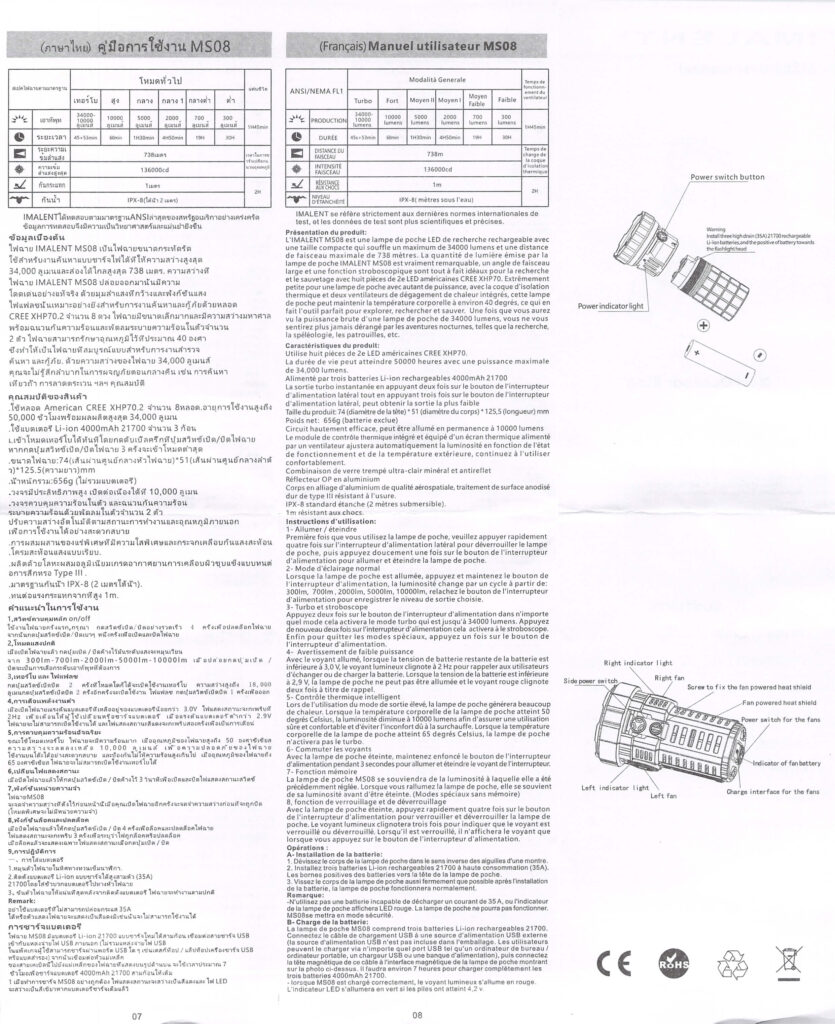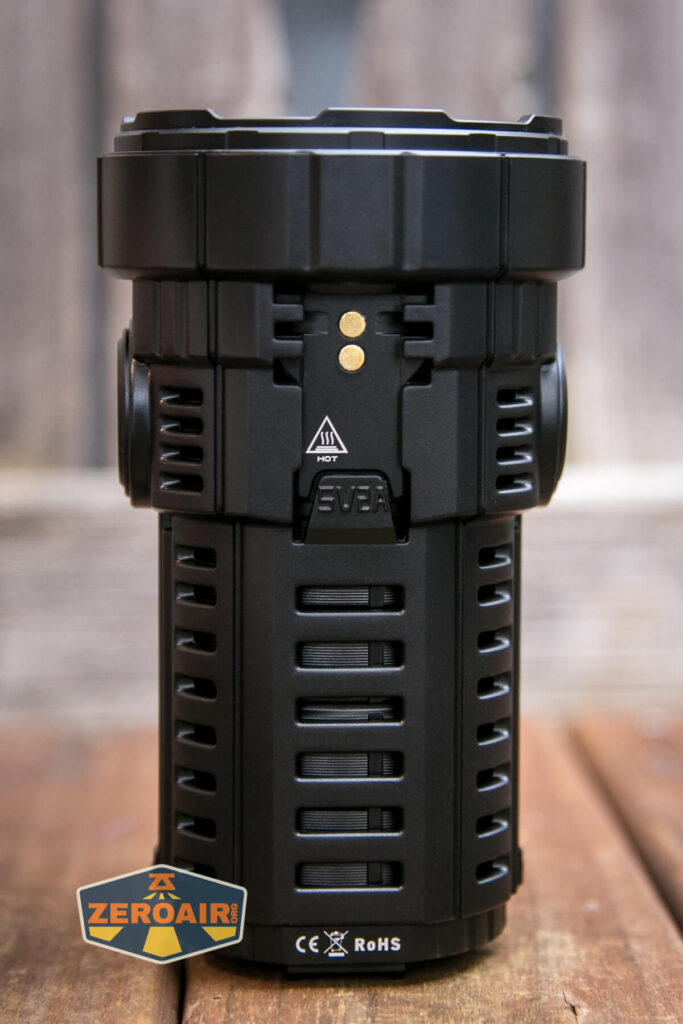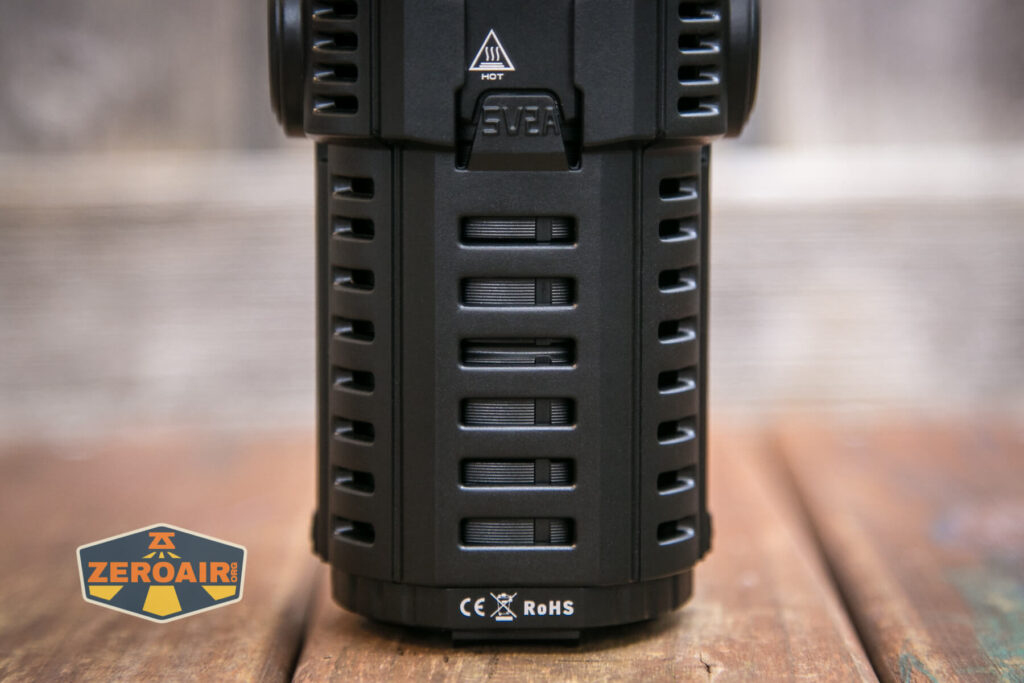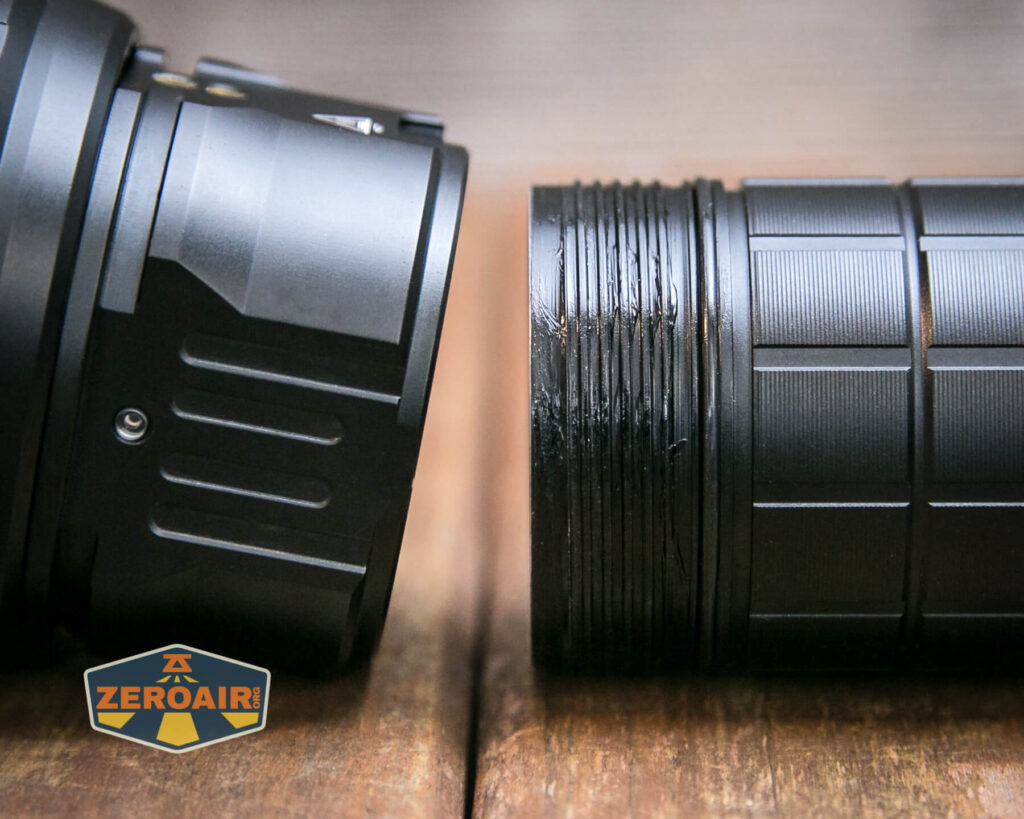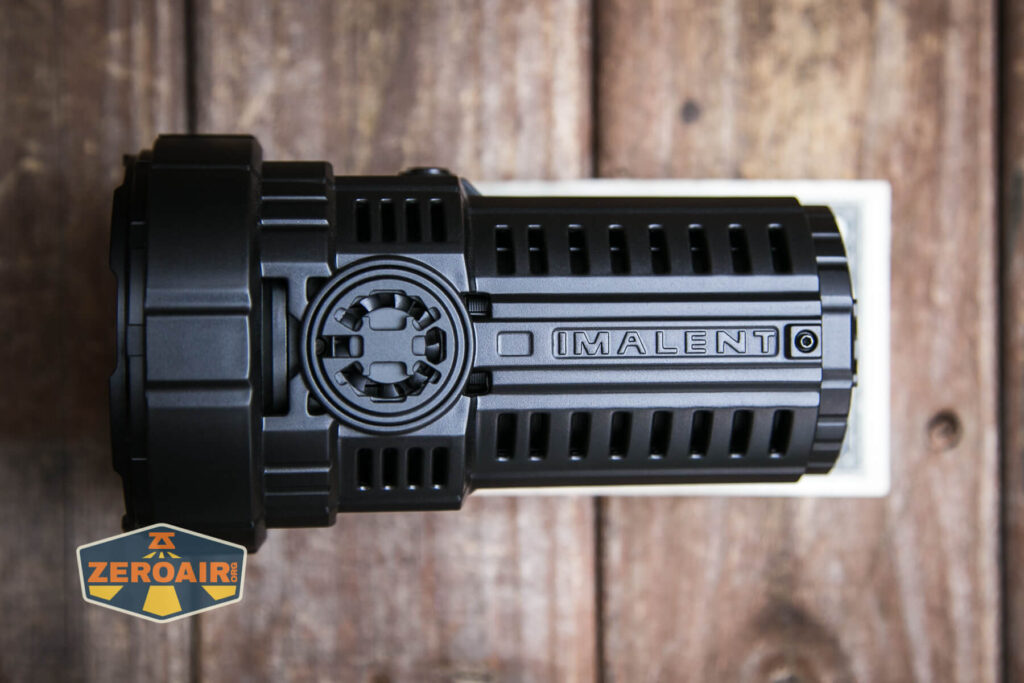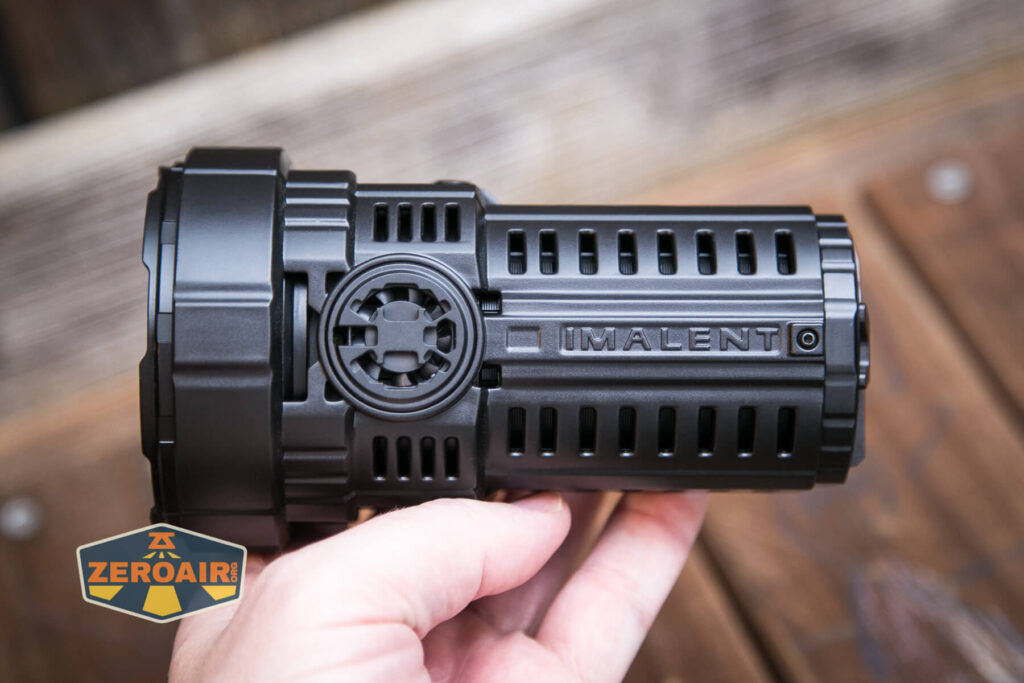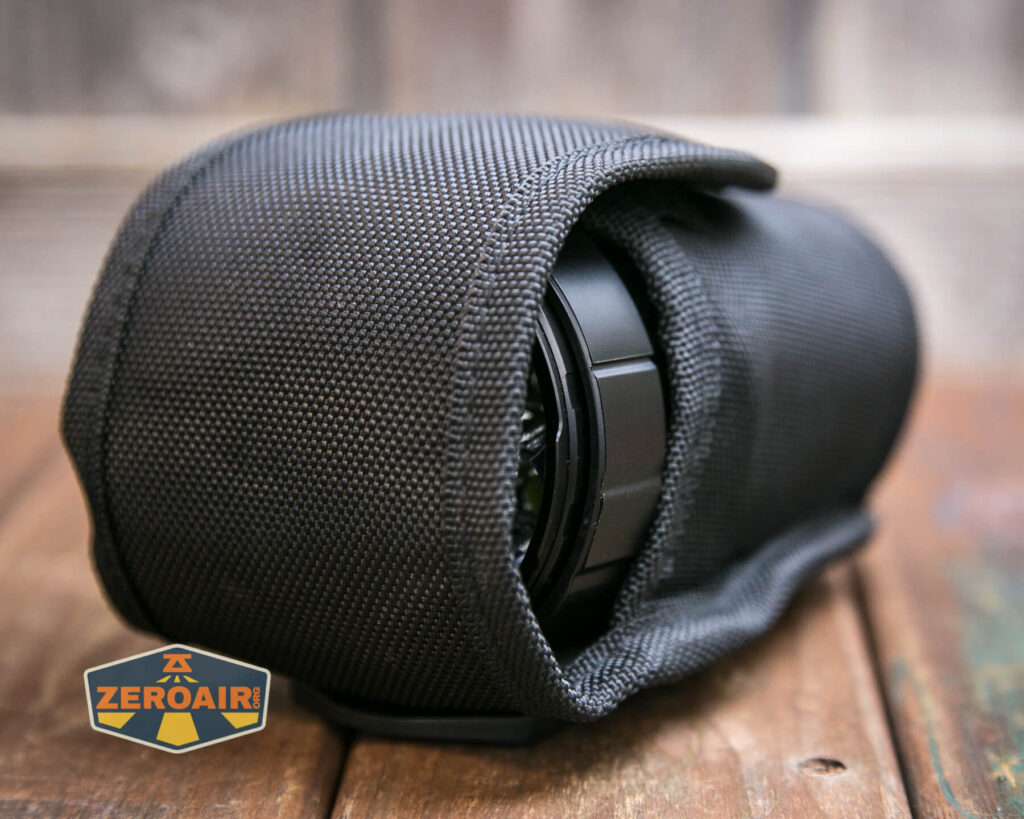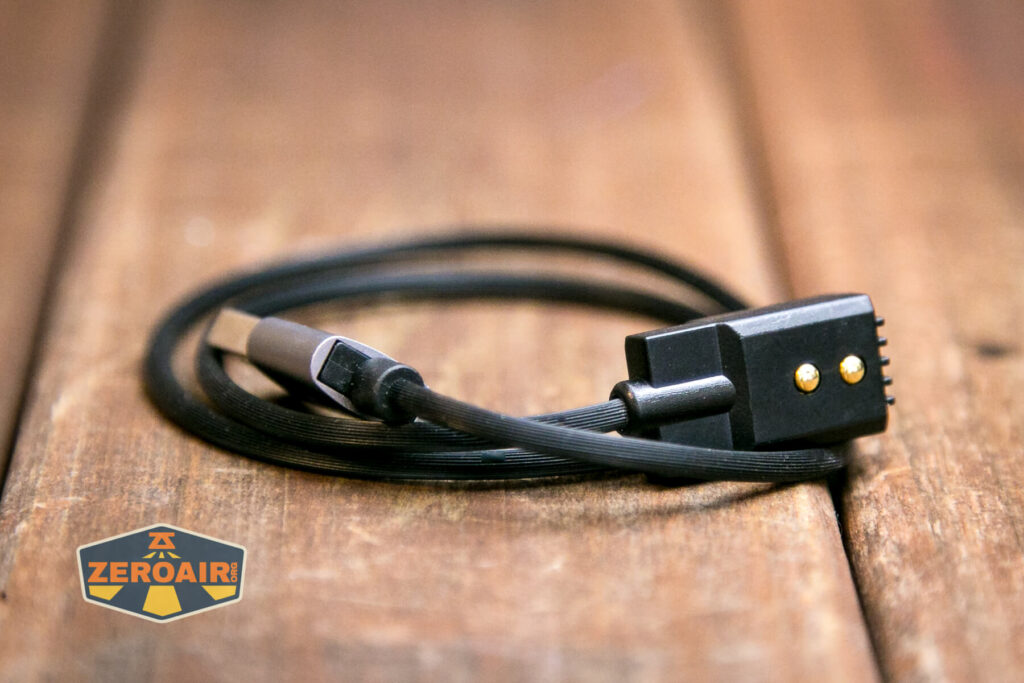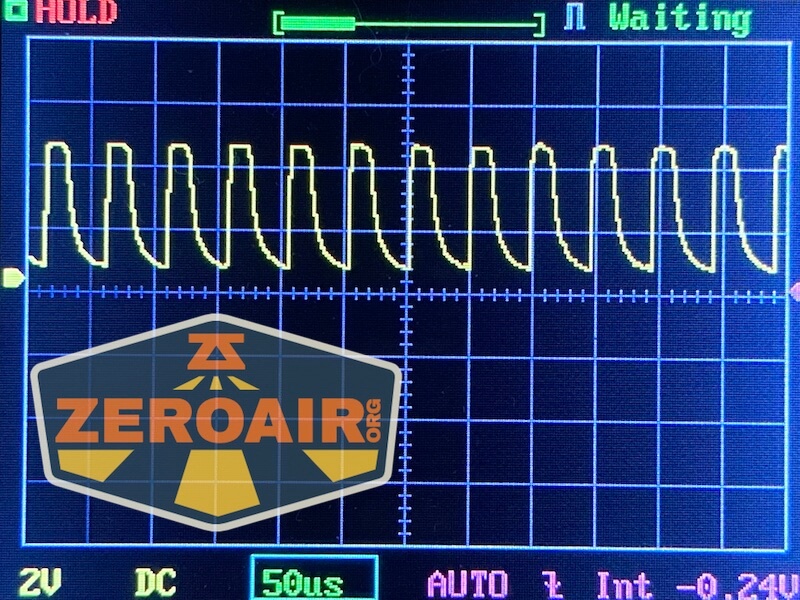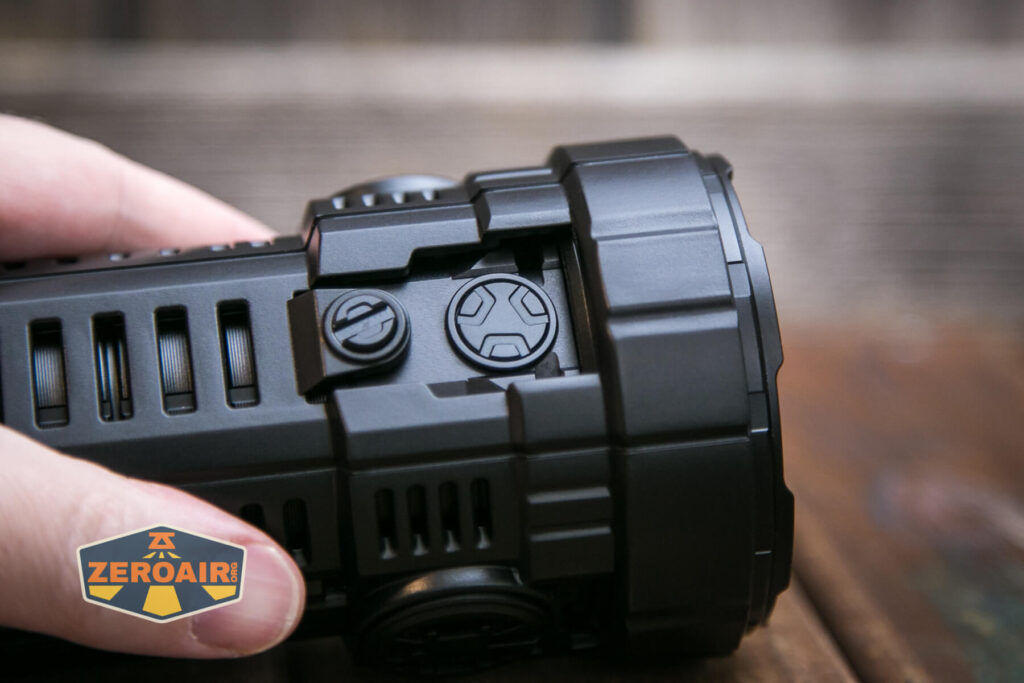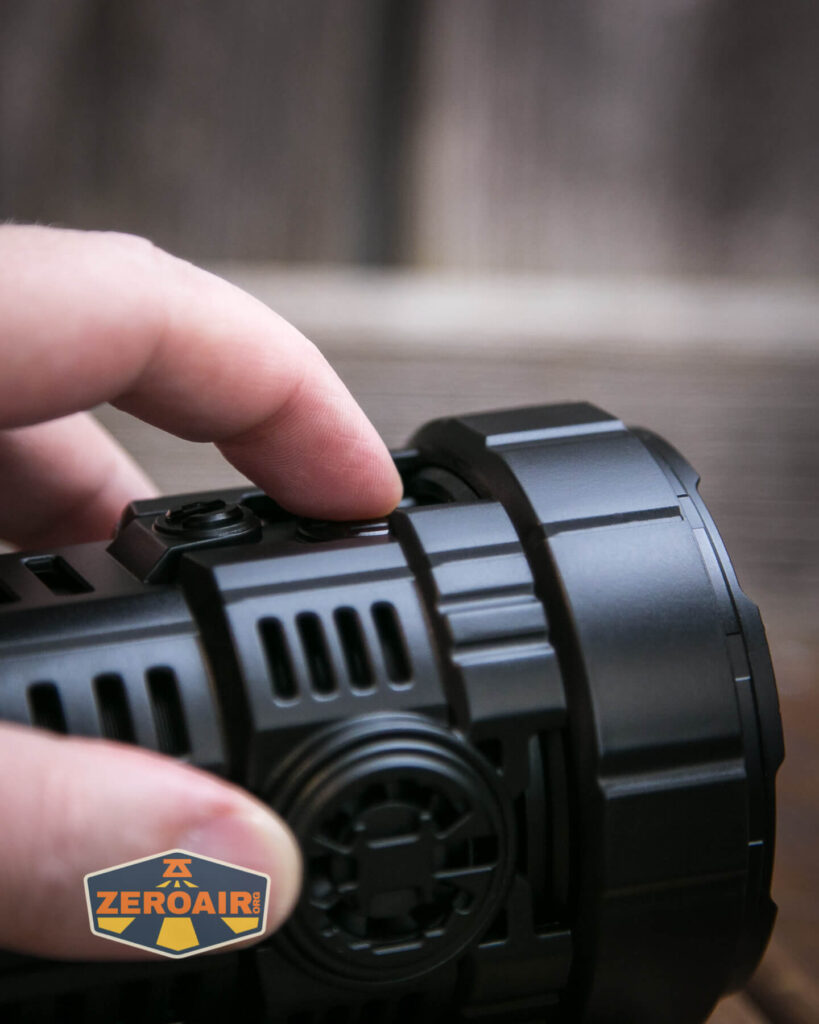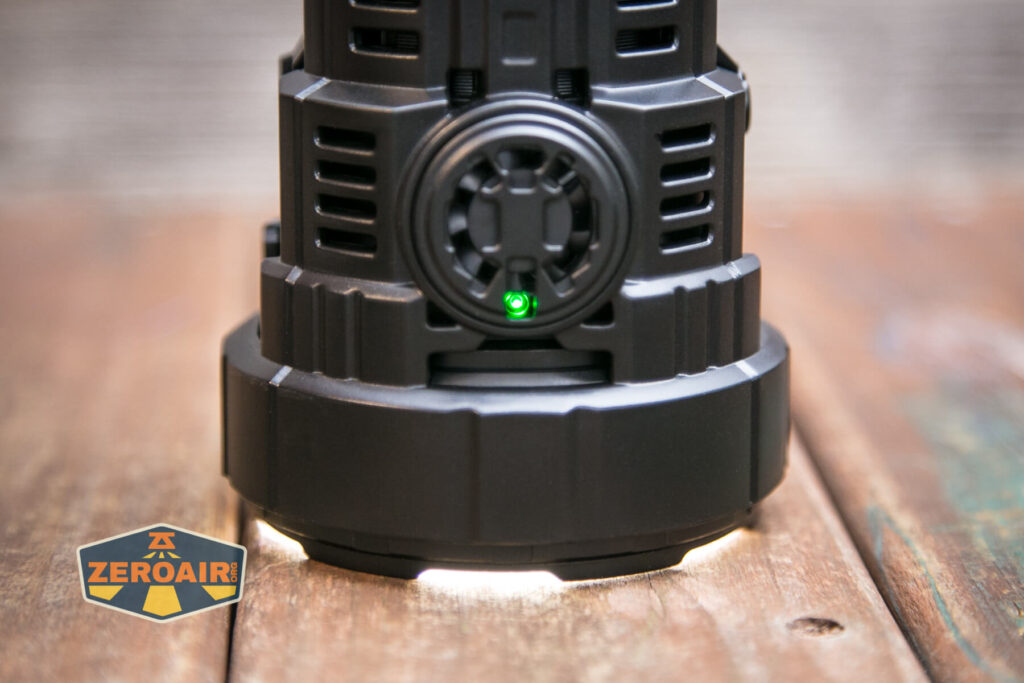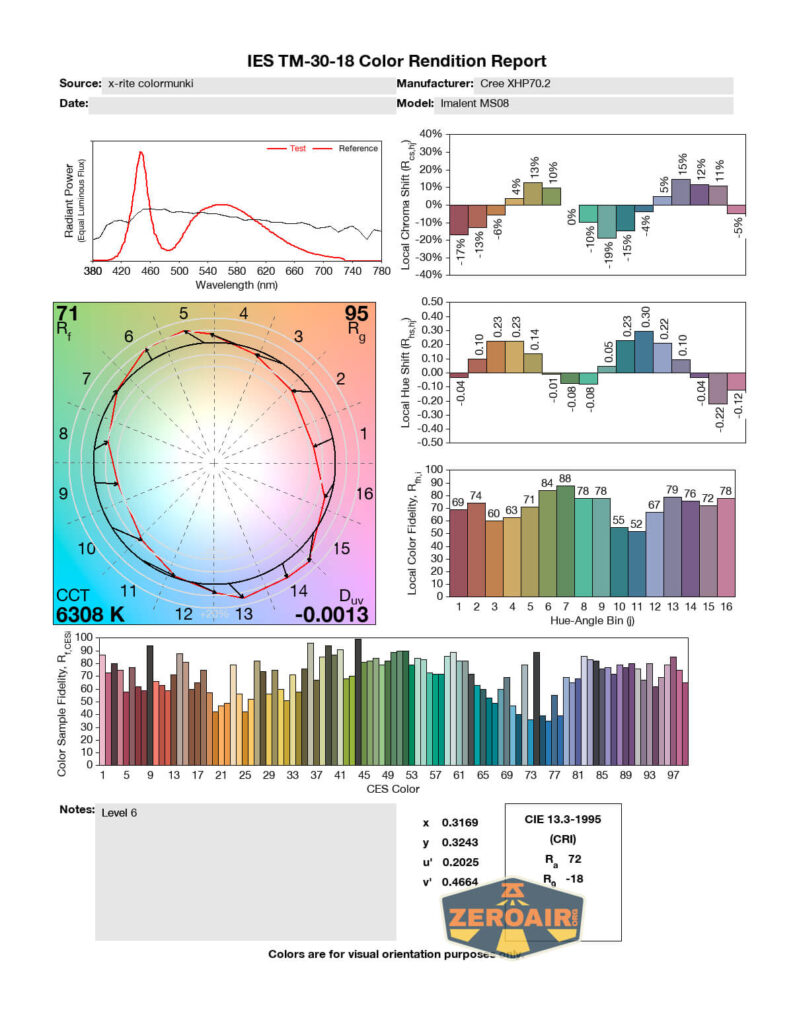Imalent MS08 Flashlight Review
The Imalent MS08 is a flashlight offering massive output from eight Cree XHP70.2 emitters and has a shroud with fans and active cooling!
Official Specs and Features
Here’s a link to the Imalent MS08 flashlight product page.
Versions
I believe there is only one version of the Imalent MS08 flashlight.
Price
The Imalent MS08 flashlight is listed at $294.95, and that includes the three 21700 cells seen in this review. The MS08 is available on Amazon, too! (referral link.)
Short Review
The Imalent MS08 flashlight is an interesting little light. It really blisters out the lumens but does not seem to meet the specified output. It falls a bit short of the claim for throw too, but I don’t think you’d buy this light for throw anyway. Beside those two negatives, the handle shroud piece is pretty neat, and I like the light for that aspect.
Long Review
The Big Table
| Imalent MS08 Flashlight | |
|---|---|
| Emitter: | Cree XHP70.2 (8) |
| Price in USD at publication time: | $294.95 on Amazon. |
| Cell: | 3×21700 |
| Turbo Runtime Graph | High Runtime Graph |
| LVP? | Yes |
| Switch Type: | E-Switch |
| Quiescent Current (mA): | 0.04 |
| On-Board Charging? | Yes |
| Charge Port Type: | Proprietary Magnetic |
| Charge Graph | |
| Power off Charge Port | No modes |
| Claimed Lumens (lm) | 34000 |
| Measured Lumens (at 30s) | 20073 (59% of claim)^ |
| Candela per Lumen | 3.2 |
| Claimed Throw (m) | 738 |
| Candela (Calculated) in cd (at 30s) | 2070lux @ 6.001m = 74545cd |
| Throw (Calculated) (m) | 546.1 (74% of claim)^ |
| Claimed CCT | – |
| Measured CCT Range (K) | 5500-6500 Kelvin |
| Item provided for review by: | Imalent |
| All my Imalent reviews! | |
^ Measurement disclaimer: Testing flashlights is my hobby. I use hobbyist-level equipment for testing, including some I made myself. Try not to get buried in the details of manufacturer specifications versus measurements recorded here; A certain amount of difference (say, 10 or 15%) is perfectly reasonable.
What’s Included
- Imalent MS08 Flashlight
- Spare o-rings (2)
- Charging cables (2) (USB to proprietary magnetic)
- Nylon pouch
- Heat shield screw (spare)
- Manual
Package and Manual
Build Quality and Disassembly
Alright, check out that handle! Is it a handle? Is it a shroud? I have called it a “shroud” a bunch but technically Imalent is referring to this as a “heat shield.” Let’s go with both.
The heat shield is a hard plastic piece that fully encases the whole light except the front/output end. This case is easily removable, but you don’t have to remove it for things like charging. So removing is really not an issue.
Interestingly, the heat shield has its own battery and even more interestingly requires separate charging. Here’s the charge port for the heat shield.
On the heat shield are a bunch of slots so that air can pass through. The Imalent MS08 flashlight still gets hot (and I mean hot) but this shield does separate the user from this heat.
On both sides of the heat shield are small fans. These fans are very quiet, and completely separately operated from the flashlight itself.
This shield is held in place by one screw. That screw has a nice big coin slot for removal. Unfortunately, that screw is not captured. A spare is included, but still, it’d have been better to just have a captured screw in this screw hole.
With the heat shield off, the MS08 looks a little lonely.
I said it above but here’s proof: the heat shield has its own power. That green indicator light near the switch indicates the fans are running.
The MS08 has an indicator LED, too.
The heat shield is directional, and on the charging side says “5V2A.” I dislike how off-center that “HOT” icon is.
A big difference in the Imalent MS08 Flashlight and another light like the Acebeam X50 is that the cells (3 21700 cells) are removable. In fact, they’re standard button top 21700 cells, too.
Threads on the MS08 are quite long. These are square cut, well lubed, and anodized. As such, it’s possible to lock the light out mechanically by loosening the head just a bit. That only works if you have the heat shield off, though! Otherwise, the head isn’t accessible in this way.
The tail end of the cell tube has springs with reasonable stiffness.
Size and Comps
Dimensions: 74mm (length) x 51mm (head diameter) x 125.5mm (body diameter)
Weight: 651g (battery included)
If the flashlight will headstand, I’ll show it here (usually the third photo). If the flashlight will tailstand, I’ll show that here, too (usually the fourth photo).
Here’s the test light with the venerable Convoy S2+. Mine’s a custom “baked” edition Nichia 219b triple. A very nice 18650 light.
And here’s the light beside my custom engraved TorchLAB BOSS 35, an 18350 light. I reviewed the aluminum version of that light in both 35 and 70 formats.
Retention and Carry
The main and only way included for carry of the MS08 is this nylon pouch. It’s a fine pouch.
The MS08 fits only in one direction – that’s bezel up. While the tail switch is accessible, the side switch (which operates the light) is not.
Power and Runtime
The Imalent MS08 includes the cells required for operation. That’s three 21700 button-top cells.
These are 4000mAh cells and seem to be of high quality.
The battery setup is a parallel configuration. That means the flashlight itself runs on 4.2V (maximum), and thus the capacity is added together, for a total capacity of 12000mAh.
I was sure I had a photo demonstrating it, but this parallel configuration does mean that the MS08 will run on a single cell. However, and this is a big however… the current required for the highest two modes will be quite dramatic for a single cell to output. I’d recommend running fewer than 3 cells only in an emergency, and only on the lower four modes.
Here are three runtime tests. Unfortunately, the output we see here does not meet the claim of 34,000 lumens. In reality, what we see even initially is well below the 34,000-lumen claim. Yes, that’s too bad! However, the initial output is still quite spectacular and does throw quite well too. (This isn’t a thrower, but as you can see below, the beam is much tighter than you’d probably guess.) A second point here. I didn’t test this light with my usual fan blowing gently over the light. Instead, I used only the provided fan (which seems fair?). And I attached my thermocouple in a place where it’d stay put…. but this isn’t really where your hands will be. The probe was somewhere between the heat shield and the flashlight body. This spot got hot enough that I had to change my temperature scale from the usual 70°C max to 80° C max. I’ve tried to show that in the scale…
For this Turbo graph (above), I let the graph run for an extra 15 minutes or so, to show how the temperature comes down (with the heat shield fans on).
The third highest output looks pretty good. Nearly stable output for 70 minutes or so at above 3000 lumens. As a matter of comparison, though, the Acebeam X50 did nearly 70 minutes at over 6000 lumens, and that output was perfectly flat.
Charging
The Imalent MS08 uses a proprietary magnetic connector with physical reverse polarity connection protection built-in.
This is the same charger type you’ve seen on other recent Imalent flashlights, so that’s a good point. This MS08 actually has two chargers, because the flashlight itself (and the three internal 21700 cells) charges separately from the heat shield.
I was… a little… surprised by this. I feel like it’d be trivial to charge this (probably tiny) heat shield battery from the MS08 battery. I do not know how the connection would look, but the heat shield battery can’t be that big, to affect runtimes by that much. Anyway, charging the heat shield is quick, especially compared to charging the MS08 itself.
It’s not really possible to accidentally connect this charger backward. You could likely force it but it has an obvious orientation, and if it doesn’t snap into the right place, you’ll likely notice.
Here are a couple of charge cycles on the MS08 and its internal 21700 cells (3). Charging takes a while! On this graph, you can observe a hard peak at 2A. I have observed the charging unit I use for testing go well over 2A, so I’m confident in saying that the light limits charging to 2A. That’s a bit disappointing. What could be even better is USB-C charging, with power delivery. At 4.2V, 2A is just 8W. Power delivery at 20W or whatever could see much quicker charging here. As is, this is essentially an “overnight charge” scenario. The flip side is that you can easily swap 21700 cells if and when needed.
Here are a couple of charge graphs for the heat shield. In these charges, I didn’t fully discharge the heat shield. I used the shield during a runtime test, and stopped it after. But still this can give some idea of charge rate, etc.
Both charging scenarios (MS08 and heat shield) have LED indicators for charge notification. Both will be lit red while charging and will turn green when charging is completed.
Modes and Currents
| Mode | Mode Claimed Output (lm) | Claimed Runtime | Measured Lumens | Tailcap Amps |
|---|---|---|---|---|
| Turbo | 34,000/10,000 | 45s-53m | 20073 | >20 |
| High | 10,000 | 60m | 8156 | ~18 |
| Middle II | 5,000 | 1h30m | 3792 | 8.55 |
| Middle I | 2,000 | 4h50m | 1645 | 3.15 |
| Middle Low | 700 | 19h | 578 | 0.92 |
| Low | 300 | 30h | 329 | 0.51 |
With how far below spec some of these higher output levels are, I wonder if Imalent has two versions, just like they do on the MS18. I tested the MS18W. Maybe there’s an MS08W too? That would explain the disparity here.
Pulse Width Modulation
Every mode displays PWM. It’s pretty fast, so you’re unlikely to notice it.
For reference, here’s a baseline shot, with all the room lights off and almost nothing hitting the sensor. Also, here’s the light with the worst PWM I could find. I’m adding multiple timescales, so it’ll be easier to compare to the test light. Unfortunately, the PWM on this light is so bad that it doesn’t even work with my normal scale, which is 50 microseconds (50us). 10ms. 5ms. 2ms. 1ms. 0.5ms. 0.2ms. In a display faster than 0.2ms or so, the on/off cycle is more than one screen, so it’d just (very incorrectly) look like a flat line. I wrote more about this Ultrafire WF-602C flashlight and explained a little about PWM too.
User Interface and Operation
Just one switch is used for the operation of the Imalent MS08 flashlight. It’s an e-switch on the head. The switch is “textured” and has a nice positive clicky action.
The action is very low.
The heat shield has a switch exactly like the flashlight switch. An e-switch with a textured cover and very low action.
Here’s a UI table!
| State | Action | Result |
|---|---|---|
| Off | Click | On (Mode Memory (excluding Turbo/Strobe) |
| On | Click | Off |
| On | Hold | Mode cycle (200/700/2000/5000/10000 order) |
| Off | Triple Click | On in Low |
| Any | Double Click | Turbo |
| Turbo | Double Click | Strobe |
| Off | Hold 3s | Iterate switch indicator light |
| Off | Click 4x | Iterate Lock (indicated by switch indicator light blinking a few times) |
This user interface is generally like the Imalent MS06 and MS03, which share the style of the RT90.
The Triple-Click to Low is an interesting choice, and while unusual, I’m pleased that off-to-Low is possible!!
I could probably put the heat shield user interface in a separate table or section but it’s very simple. Click the tail switch to iterate the fans. That’s all there is to it. As far as I can tell, nothing else can be performed via the tail switch.
LED and Beam
Eight of the same emitters are used in the Imalent MS08 flashlight. These 8 are Cree XHP70.2 emitters in an unstated CCT. Each has a little reflector.
I’m happy that the bezel has a bit of shape to it, so that light will escape when the MS08 headstands.

LED Color Report (CRI and CCT)
I don’t see a report anywhere of the CCT of these Cree XHP70.2 emitters. Based on my tests, the lower output levels are in the 5500K range, while the higher output levels ease into the 6500K range. CRI falls in around 70, which is about to be expected (and somewhat low).
Beamshots
These beamshots are always with the following settings: f8, ISO100, 0.3s shutter, and manual 5000K exposure.
Tint vs BLF-348 (KillzoneFlashlights.com 219b version) (affiliate link)
I keep the test flashlight on the left, and the BLF-348 reference flashlight on the right.
I compare everything to the KillzoneFlashlights.com 219b BLF-348 because it’s inexpensive and has the best tint!
Conclusion
What I like
- Build quality is great
- Uses standard 21700 button top cells
- Cells are user-replaceable
- Great user interface
- Fans are not loud
- It’s just very neat (seriously, there’s no quantifiable way to state this, but it’s just a neat light to have and hold and use. It’s fun.)
What I don’t like
- Doesn’t meet specifications (even initially) for output
- Also does not hit the throw specification
- Gets so hot (but there’s some protection with the heat shield)
- Fans never seem to turn on on their own (would be safer if they did)
- Heat shield must be charged separately
Notes
- This content originally appeared at zeroair.org. Please visit there for the best experience!
- For flashlight-related patches, stickers, and gear, head over to PhotonPhreaks.com!
- Please use my amazon.com referral link to help support zeroair.org!
- Please support me on Patreon! I deeply appreciate your support!







